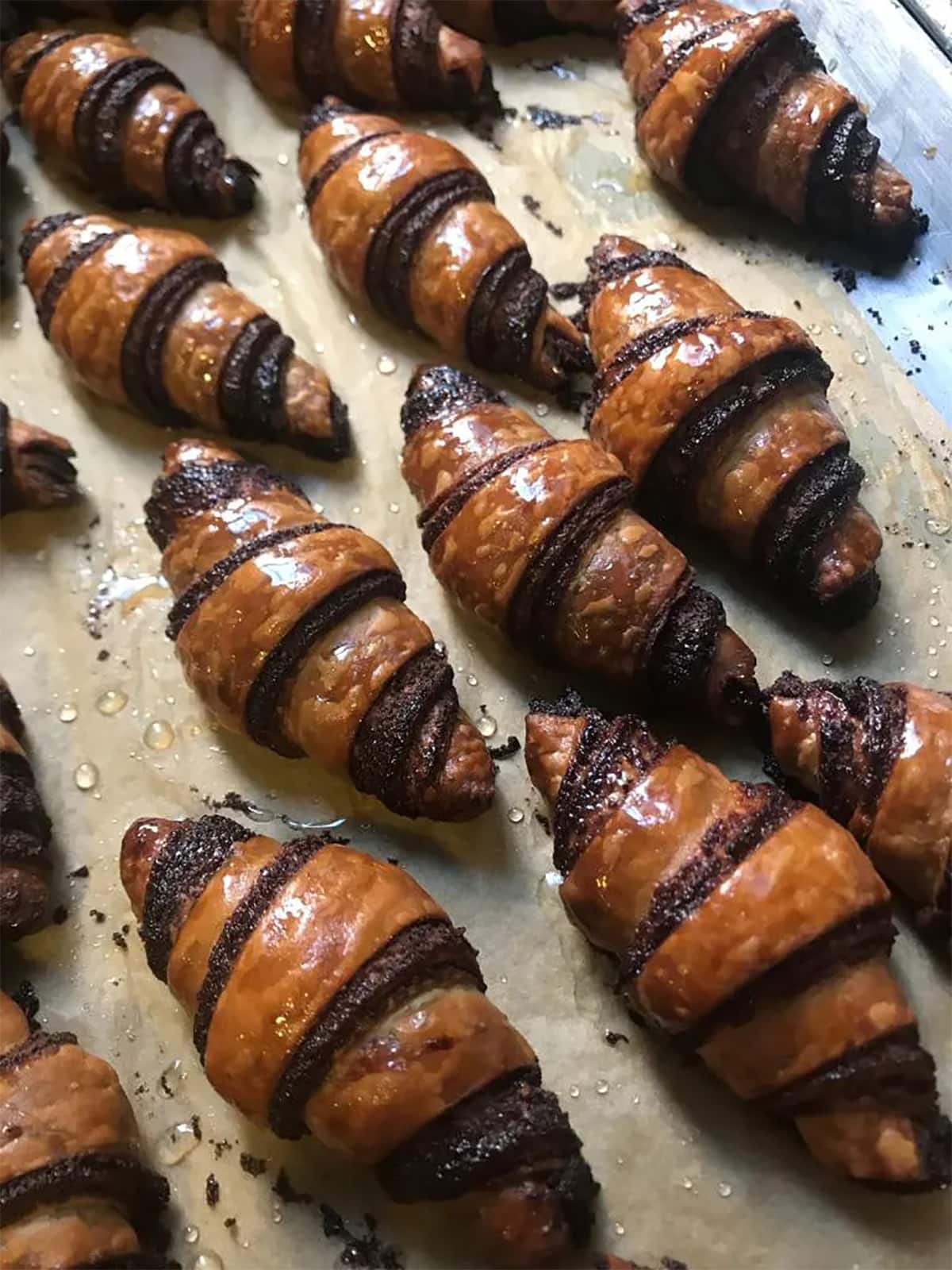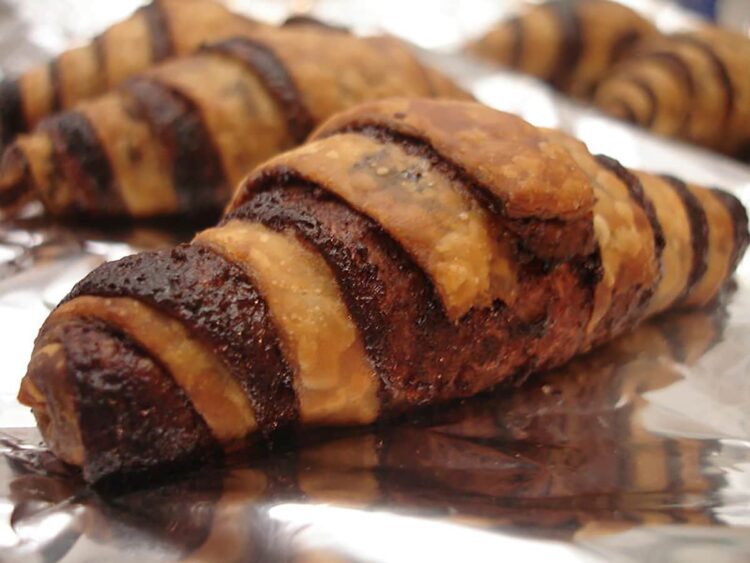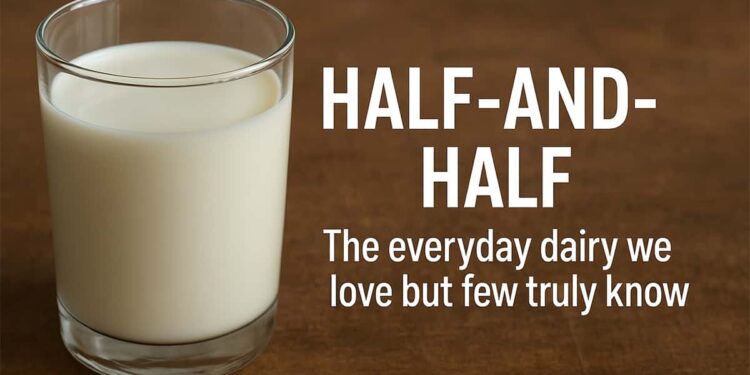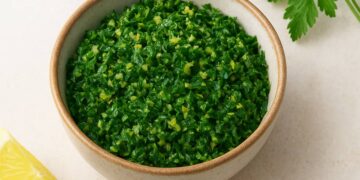Enjoy this authentic Onion Rolls Recipe—wait sorry! “Rugelach Recipe”—flaky, buttery, filled Jewish pastries made at home with jam or nuts, a family favorite.
Introducing Rugelach: Little Cookies Full of Memories
I’ve always loved baking, but there’s nothing I love more than rugelach—those little crescent-shaped Jewish cookies. I first tasted them during the holidays at my grandparents’ house: tiny cookies filled with jam or chocolate that were gone in minutes. Those memories made me want to try making them myself. [newyorker.com]
After years of practice, I finally found the perfect recipe. Many people say they taste “just like grandma made”—crispy, soft, and full of flavor. This recipe is inspired by trusted sources like Joan Nathan’s cookbook and Tori Avey’s blog, which combine traditional recipes with simple ingredients.
What Are Rugelach?
Rugelach comes from the Yiddish word for “little roll.” This pastry originated in Jewish communities in Poland and Eastern Europe, then developed in America. It is typically made with a cream cheese or sour cream base, then filled with various fillings such as fruit jam, nuts, cinnamon, or chocolate. [wikipedia.org]
Its rich flavor and crunchy texture are due to the generous use of butter and cream cheese. In America, rugelach became increasingly popular when Jewish immigrants began incorporating cream cheese into their recipes.
Why Is Rugelach Recipe Worth Trying?
- Tested: This recipe is based on the proven recipes of Jewish pastry experts.
- Experienced: After hundreds of attempts, I know this recipe will produce consistently delicious cookies.
- There’s a Story: This recipe is also crafted with historical knowledge, unique ingredients, and cultural significance.
Rugelach Recipe (Makes 30–40 Cookies)
Dough Ingredients:
- 225 g cream cheese (cold)
- 225 g unsalted butter (cold)
- 240 g all-purpose flour
- 2 tbsp granulated sugar
- ¼ tsp salt
- 1 tsp vanilla (optional)
Filling Ingredients (Choose one or a Combination):
- ½ cup jam (apricot, raspberry, strawberry)
- ¼ cup brown sugar + 1 tsp cinnamon
- ½ cup chopped walnuts or pecans
- Chocolate chips or chopped chocolate (optional)
Topping (optional):
- 1 beaten egg (for brushing)
- Sugar or cinnamon for sprinkling
How to Make Rugelach

1. Make the Dough
- Combine the cream cheese, butter, sugar, salt, and vanilla in a food processor until the mixture resembles coarse crumbs.
- Add the flour and mix until the dough comes together.
- Shape into a disc, wrap in plastic wrap, and refrigerate for at least 1 hour (longer is better).
2. Roll and Fill
- Divide the dough into 4 portions.
- Roll each portion into a thin circle (about 30 cm in diameter).
- Spread your favorite filling, but not too thickly to prevent leaks.
3. Cut and Roll
- Cut the circle into 12–15 triangles.
- Roll them from the wide side to the point, forming a crescent shape.
- Place them on a baking sheet lined with parchment paper, the seam facing down.
4. Chill and Bake
- You can freeze them briefly (15 minutes) to keep them in shape while baking.
- Brush with egg wash and garnish with toppings if desired.
- Bake in a preheated oven at 175°C for 20–25 minutes, until golden brown.
Tips for Successful Rugelach
- Use cold ingredients: Cold butter and cream cheese create a better texture.
- Don’t overmix: Just until combined, not too smooth.
- Chill the dough: This is important for easy rolling and to prevent the cookies from breaking.
- Choose a filling that isn’t too wet: Thick jam, nuts, or chocolate work best. [myjewishlearning.com]
My Personal Touch
I like to mix apricot jam with walnuts and grated orange zest—the flavors are fresh and balanced. Sometimes I also use Nutella and dried strawberry powder for a unique chocolate-strawberry version.
Every time a friend tastes it and asks, “Where did you buy this?”, I smile. Because for me, rugelach isn’t just a cookie—it’s a memory, a tradition, and a taste of home.
If you love baking and want to try something special but still easy to make, these rugelach could be a fun choice! Want me to help you turn this into an Indonesian version?
The Origins and Cultural Significance of Rugelach
Rugelach originates from Eastern Europe, particularly Poland. It was brought by Jewish communities and later adapted by Jews in America. The modern version, which uses a cream cheese filling, remains popular today.
Rugelach gained popularity in America around the mid-20th century, thanks to renowned cookbook writers like Joan Nathan and Maida Heatter. Through their books and recipes, rugelach became a favorite among Jewish and non-Jewish families alike.
To this day, rugelach is often served during important holidays like Hanukkah, Rosh Hashanah, and Shavuot. This pastry is considered a symbol of sweetness, tradition, and togetherness.
Check out more:
How to Serve & Store Rugelach
Serving:
After baking, let the rugelach cool on a wire rack to keep it crisp. Sprinkle with powdered sugar, if desired, and serve with tea or coffee. This pastry is also perfect for family gatherings or holidays.
Storage:
- Store in a sealed container at room temperature for 3–5 days.
- If you want it to last longer, you can freeze it after baking—it will last up to 1 month.
- Unbaked dough can also be frozen and baked later when needed.
[Source: seriouseats.com]
Conclusion: Why the Rugelach Recipe Is Special
This rugelach recipe is special because:
- Experienced: Created and perfected through extensive home baking experience.
- Trusted: Using techniques from expert sources like Tori Avey and Joan Nathan.
- Research-Backed: Based on in-depth historical and culinary information.
- Full of Meaning: Made with a personal touch and a recipe passed down through generations.
Whether you’re celebrating a Jewish holiday or simply want to enjoy a delicious cookie filled with jam or chocolate, these rugelach are worth a try. Making them at home will bring you a sense of pride and joy—because they’re not just delicious, they’re also full of meaning.
Happy baking! May your homemade rugelach bring joy and sweetness into your days.













